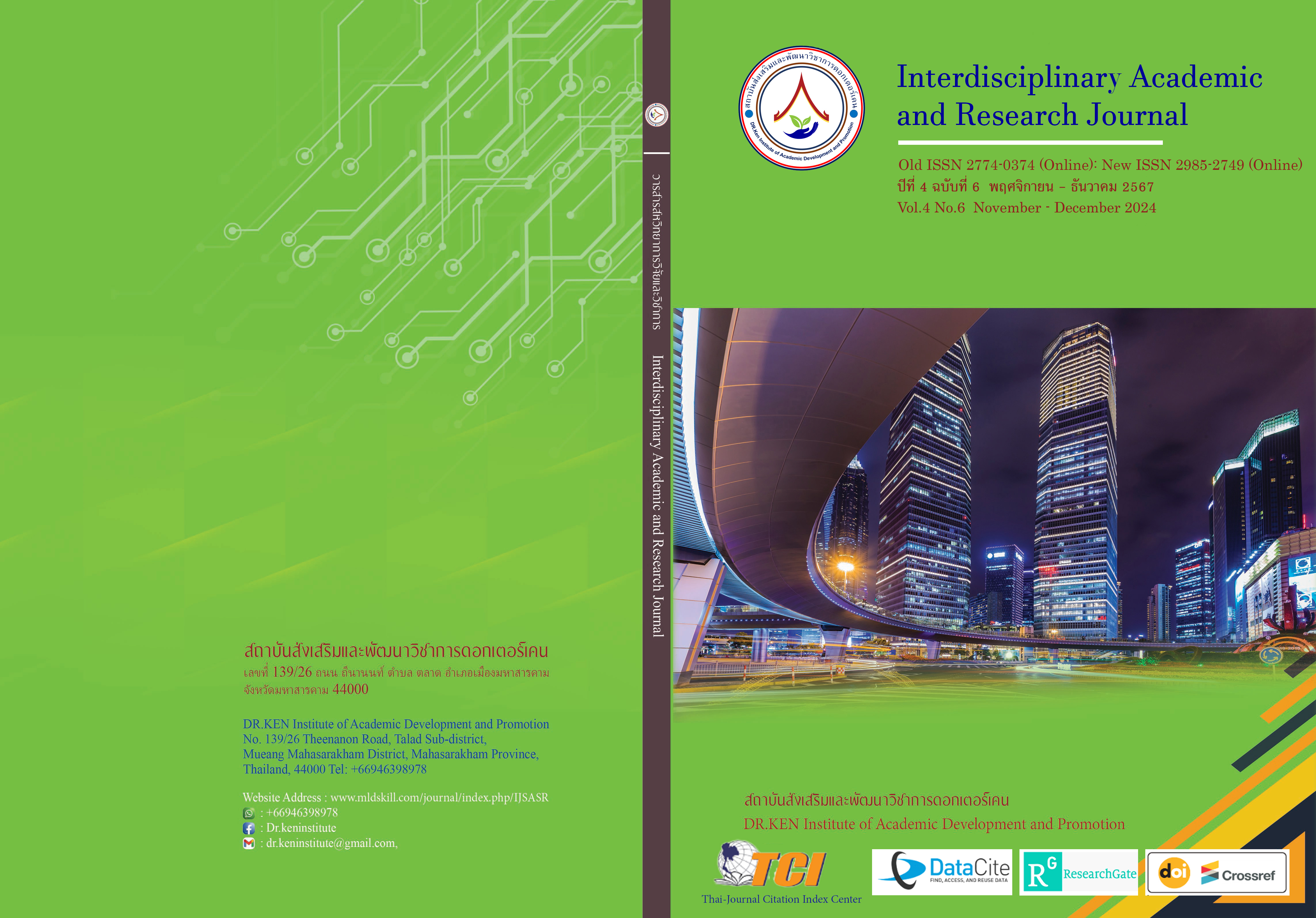Guidelines for Promoting Music Education for Secondary School under the Office of Samut Prakan Secondary Education Service Area
DOI:
https://doi.org/10.60027/iarj.2024.279283Keywords:
Guidelines for promoting educational management, Music Education Management, Music ClassroomAbstract
Background and Aims: Music education in secondary schools in Thailand at present is linked to the 2008 Basic Education Core Curriculum, in which music is included in the Arts curriculum. Since the study time is determined by the curriculum structure, there is not enough time to fully develop the learners. The conditions and problems of music education are not responsive to the regulations, laws, and policies of the country. In order to promote music education, the Ministry of Education has created a project of music classrooms and manuals as a standard criterion for music education. For these reasons, this research aims to 1) study the conditions and problems of music education in secondary schools under the Office of the Secondary Education Service Area of Samut Prakan, and 2) analyze and propose guidelines for promoting music education for secondary schools under the Office of the Secondary Education Service Area of Samut Prakan.
Methodology: This research is qualitative research. The researcher used in-depth interviews with key informants, namely, school administrators and teachers, totaling 8 people. The researcher used a purposive sampling method. The researcher interviewed the informants until saturated and sufficient data were obtained, constant and certain.
Results: (1) Conditions and problems in music education management in secondary schools are divided into 6 areas as follows: 1) Buildings and facilities 2) Equipment 3) Teachers 4) Students 5) Curriculum 6) Budget. (2) Guidelines for promoting music education management for secondary schools are divided into 5 areas as follows: Buildings and facilities Equipment Teachers Students Curriculum, which should be promoted in all areas of education management so that students can develop to their full potential.
Conclusion: Guidelines for promoting music education for secondary schools under the Office of the Samut Prakan Secondary Education Area found 5 approaches: Buildings: Buildings for music practice Soundproof rooms, air-conditioned rooms, facilities, safety for teachers and students Equipment: Thai and international musical instruments of sufficient quality for students, books, textbooks, and sheet music for students to research and create inspiration Teachers: Teachers who teach in their major subjects, provide self-development training Students: Presentation of work, promotion of further music education at a higher level Curriculum: Designing a music curriculum separate from art subjects, organizing teaching and learning activities
References
กระทรวงวัฒนธรรม. (2559). สภาพปัญหาและอุปสรรคที่มีต่อดนตรีไทย. Retrieved from: https://www.nationtv.tv/main/content/378514874
กระทรวงศึกษาธิการ. (2562). คู่มือการจัดการเรียนการสอนโครงการห้องเรียนดนตรี. กรุงเทพฯ: กระทรวงศึกษาธิการ
ธันยาภรณ์ โพธิกาวิน. (2563). แนวทางการพัฒนาการเรียนการสอนดนตรีสำหรับโรงเรียนมัธยมศึกษา อำเภอบางเลน จังหวัดนครปฐม. วารสารวิชาการ สถาบันวิทยาการจัดการแห่งแปซิฟิค, 6(1), 26-38.
พระราชบัญญัติการศึกษาแห่งชาติ พ.ศ. 2542. (2542). ราชกิจจานุเบกษา (เล่ม 116 ตอนที่ 27ก น. 4-8). กรุงเทพฯ: สำนักงานราชกฤษฎีกา
ยุทธนา ฉัพพรรณรัต์. (2561). การศึกษาสภาพและแนวทางในการจัดการทรัพยากรดนตรีศึกษาในสถานศึกษาของประเทศไทย : มิติการกาหนดและขับเคลื่อนนโยบายกระทรวงวัฒนธรรม. โครงการวิจัยทุนอุดหนุนการวิจัยจากกรมส่งเสริมวัฒนธรรม กระทรวงวัฒนธรรม ประจำปีงบประมาณ 2561.
ยุทธศาสตร์ (พ.ศ. 2561-2580). (2561). ราชกิจจานุเบกษา (เล่ม 135 ตอนที่ 82ก: 36-39). Retrieved from: https://www.ratchakitcha.soc.go.th/DATA/PDF/2561/A/082/T_0001.PDF
รัฐธรรมนูญแห่งราชอาณาจักรไทย. (2560). ราชกิจจานุเบกษา (เล่ม 134 ตอนที่ 40ก: 14). Retrieved from: https://www.parliament.go.th/ewtcommittee/ewt/draftconstitution2/more_news.php?cid=87
สำนักงานเขตพื้นที่การศึกษามัธยมศึกษาสมุทรปราการ. (2565). แผนพัฒนาการศึกษาขั้นพื้นฐาน พ.ศ. 2566 - 2570 สำนักงานเขตพื้นที่การศึกษามัธยมศึกษาสมุทรปราการ. Retrieved from: https://www.sesaosp.go.th/website/wp-content/uploads/2023/01/แผนพัฒฯ-66-70.pdf
สำนักงานคณะกรรมการการศึกษาขั้นพื้นฐาน. (2562). ประชุมปฏิบัติการแนวทางบริหารจัดการโครงการห้องเรียนดนตรี. Retrieved from: https://www.obec.go.th/archives/88004
สิชฌ์น์เศก ย่านเดิม. (2560). แนวทางการสนับสนุนการเรียนดนตรี. Fine Arts Journal: Srinakharinwirot University, 21(1), 2–11. Retrieved from https://so01.tci-thaijo.org/index.php/jfofa/article/view/92882
หัสดี นันทวรรณ. (2557). ความต้องการอาคารสถานที่ในการจัดการเรียนการสอนดนตรีของครูดนตรีโครงการโรงเรียน หลักสูตรการดนตรีกรุงเทพมหานคร. วารสารศิลปกรรมศาสตร์ มหาวิทยาลัยขอนแก่น, 6(1), 46-68. https://so02.tci-thaijo.org/index.php/fakku/article/view/26941
อภินันท์ พฤกษะศรี (2563). กระบวนการการบริหารจัดการวงดนตรีไทยเพื่อความเป็นเลิศของโรงเรียนมัธยมศึกษาสังกัดสำนักงานคณะกรรมการการศึกษาขั้นพื้นฐาน. วารสารศึกษาศาสตร์ มหาวิทยาลัยทักษิณ, 20(2), 16-30. https://so02.tci-thaijo.org/index.php/eduthu/article/view/241282
อาทิตย์ โพธิ์ศรีทอง. (2559). การพัฒนาหลักสูตรฝึกอบรมครูเพื่อส่งเสริมสมรรถนะการจัดการเรียนรู้ทางด้านดนตรีในศตวรรษที่ 21. ปริญญานิพนธ์ปริญญาดุษฎีบัณฑิต, มหาวิทยาลัยศรีนครินทรวิโรฒ
Abril, C. R., & Gault, B. M. (2008). The state of music in the elementary school: The principal's perspective. Journal of Research in Music Education, 56(1), 68-81. https://doi.org/10.1177/0022429408323075
Bates, V. C. (2016). Critical social foundations of music education. Oxford University Press.
Berg, M. H., & Hall, J. (2020). Equity and access in music education: Historical perspectives and contemporary challenges. Music Educators Journal, 106(4), 23-28. https://doi.org/10.1177/0027432120913410
Conway, C., & Hodgman, T. (2006). Teaching music in higher education. Oxford University Press.
Hallam, S. (2010). The power of music: Its impact on the intellectual, social and personal development of children and young people. International Journal of Music Education, 28(3), 269-289. https://doi.org/10.1177/0255761410370658
Hodges, D.A. (2005). Why study music? [Article]. International Journal of Music Education, 23(2), 111-115. https://doi.org/10.1177/0255761405052403
National Association for Music Education. (2014). National standards for music education. Retrieved from https://nafme.org/my-classroom/standards/
Downloads
Published
How to Cite
Issue
Section
License
Copyright (c) 2024 Interdisciplinary Academic and Research Journal

This work is licensed under a Creative Commons Attribution-NonCommercial-NoDerivatives 4.0 International License.
Copyright on any article in the Interdisciplinary Academic and Research Journal is retained by the author(s) under the under the Creative Commons Attribution-NonCommercial-NoDerivatives 4.0 International License. Permission to use text, content, images, etc. of publication. Any user to read, download, copy, distribute, print, search, or link to the full texts of articles, crawl them for indexing, pass them as data to software, or use them for any other lawful purpose. But do not use it for commercial use or with the intent to benefit any business.
















.png)


